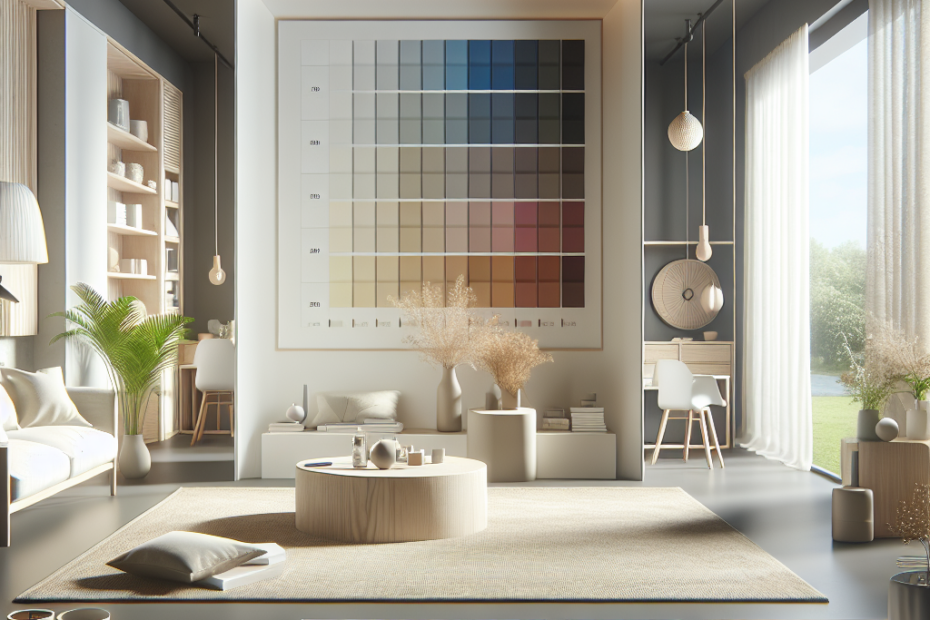“`html
Choosing the Right Minimalist Color Palette for a Minimalist Home
Minimalism continues to grow in popularity, with many homeowners yearning for simplicity and tranquility in their living spaces. They hope to achieve this by selecting the right minimalist color palette for their homes. According to a survey by Statista, 23% of U.S. adults have expressed a preference for minimalist design in their home decor choices (source). By understanding how to choose a minimalist color scheme, they can transform their home into a calming yet stylish retreat.
Understanding Minimalist Color Palettes
In a minimalist home, less is more. The principle involves removing clutter and embracing simplicity. The colors they choose play a huge role in achieving this effect. A minimalist color palette often comprises neutral and muted tones, creating a calming and unobtrusive backdrop for daily life. They usually turn to colors like whites, grays, beiges, and blacks. These colors are chosen for their ability to harmonize with other elements of the home and evoke serenity.
Importance of Choosing the Right Colors
The colors they pick can influence the mood and feeling of a room. White and off-white shades are often chosen for their purity and ability to make spaces appear larger and brighter. Grays can range from cool and modern to warm and inviting, while beiges provide a soft and cozy feel. Black, although used sparingly, adds contrast and sophistication. When they mindfully select these colors, their minimalist spaces blend beauty with practicality.
Creating Contrast and Depth
While minimalism favors simplicity, introducing subtle contrast can enhance a room’s depth and interest. They might use a mix of light and dark shades for this purpose. For instance, a soft beige wall paired with charcoal gray furniture creates a balanced contrast without overwhelming the senses. Incorporating varying textures, such as a plush gray rug on polished white floors, can also add dimension without diverting from minimalist aesthetics.
Using Accent Colors Thoughtfully
Accents can breathe life into minimalist spaces when used thoughtfully. While the base palette remains subdued, they might introduce soft pastel shades or earthy tones as accents. A light blue throw, a sage green potted plant, or muted terracotta cushions can add personality without clashing with the overall minimalist theme. It’s important that these accent colors complement and enhance their primary palette rather than dominate it.
Drawing Inspiration from Nature
Nature offers endless inspiration for minimalist color palettes. They might consider the muted tones of a sandy beach, the misty hues of a foggy morning, or the soft greens found in a forest. Incorporating these natural shades evokes a sense of peace and brings the serenity of the outdoors into the home. They can look to nature as a reliable guide when picking the perfect tones for their minimalist space.
Applying Minimalist Colors to Different Spaces
When choosing colors, they should consider the function of each room. For example, calming whites and grays work well in bedrooms to promote relaxation, while living rooms might benefit from warmer neutrals for coziness. Kitchens can feature crisp whites for a clean and efficient look, whereas bathrooms can be adorned in soft whites or grays for a spa-like atmosphere. The key is to adapt the color palette to fit the mood they wish to create in each space without deviating from their minimalist ethos.
| Color | Use | Effect |
|---|---|---|
| White/Off-white | Walls, Ceilings | Brightness, Expansiveness |
| Gray | Furniture, Accent walls | Modern, Soothing |
| Beige | Textiles, Rugs | Warmth, Comfort |
| Black | Accents, Frames | Contrast, Elegance |
| Pastels/Earthy Tones | Accents, Art | Character, Calmness |
Key Takeaways
- A minimalist color palette consists of neutral and muted tones, which create a serene environment.
- Proper color choices can affect the mood, appearance, and function of a room.
- Subtle contrast and texture can add depth to minimalist spaces without overwhelming them.
- Accent colors should be used sparingly to complement and not detract from the primary palette.
- Nature is an excellent source of inspiration when choosing minimalist colors.
FAQs
-
What are the best colors for a minimalist home?
Neutral colors like whites, grays, blacks, and beiges are ideal for minimalist homes. They promote calmness and simplicity.
-
Can I use bold colors in a minimalist home?
While bold colors aren’t typical in minimalist homes, small accents can be integrated for an added touch of personality.
-
How can I add warmth to a minimalist space?
Warm tones like soft beiges and earthy colors can add warmth without compromising on minimalism.
-
Are there any unwanted effects of using too much white?
Excessive white can make spaces feel sterile; adding texture and subtle color variations can prevent this.
-
How do I choose accent colors?
Choose soft, muted shades that complement your primary minimalist palette, inspired by nature or subtle pastels.
“`
